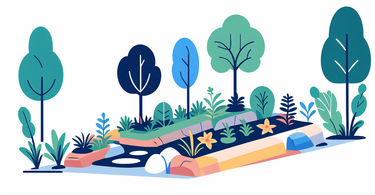Understanding the Fundamentals of Garden Bed Setup
Choosing the Right Soil and Components
Good soil is the key to a thriving garden bed. Start with a mix of topsoil, compost, and peat moss. This blend provides nutrients and retains moisture. Add sand for better drainage in clay soils. For sandy soils, add more organic matter to improve water retention. Test your soil pH and adjust as needed. Most flowers prefer a slightly acidic to neutral pH (6.0-7.0). Use lime to raise pH or sulfur to lower it. Consider adding slow-release fertilizers to give your flowers a steady nutrient supply throughout the growing season.

Optimizing Water Drainage and Aeration
Proper drainage is crucial for healthy roots. Ensure your garden bed has a slight slope to prevent water pooling. If drainage is poor, consider raised beds or adding drainage pipes. Mix in perlite or vermiculite to improve soil structure and aeration. These materials create air pockets, allowing roots to breathe and grow. Avoid compacting the soil by not walking on the bed. Use stepping stones or pathways for access. Regularly loosen the top layer of soil to maintain good aeration.
The Importance of Garden Bed Liners and Edging
Garden bed liners prevent weed growth and soil erosion. They also help maintain moisture levels. Choose permeable liners to allow water drainage. For edging, consider materials like brick, stone, or plastic. Edging defines your garden bed and prevents grass invasion. It also adds a polished look to your garden. Install edging slightly below grass level for easy mowing. Ensure the edging is sturdy enough to withstand weather and lawn care equipment.
Best Practices for Flower Display in Garden Beds
Selecting the Ideal Flowers and Plants
Choose flowers that suit your climate and sunlight conditions. Consider bloom times to ensure year-round color. Mix annuals for quick color and perennials for long-term structure. Some popular choices include:

- Sunflowers for height and drama
- Petunias for long-lasting color
- Zinnias for easy care and variety
- Marigolds for pest resistance
- Pansies for cool-season blooms
Include plants with different textures and leaf shapes for visual interest. Don't forget to add some evergreens for winter appeal. Research plant heights and spreads to create a balanced look. Place taller plants at the back and shorter ones in front.
Seasonal Considerations for Flower Arrangements
Plan your garden for each season. Spring bulbs like tulips and daffodils offer early color. Summer perennials like coneflowers and black-eyed Susans provide long-lasting blooms. For fall, consider asters and chrysanthemums. Winter interest can come from ornamental grasses and berry-producing shrubs. Rotate annuals seasonally for fresh looks. Plant cool-season annuals like pansies in spring and fall. Use heat-loving annuals like petunias and marigolds in summer. Consider succession planting to extend bloom times.
Creative Ideas for Flower Bed Design
Create focal points with unique planters or garden art. Use color theory to create harmonious or contrasting schemes. Try a monochromatic bed using different shades of one color. Or go bold with complementary colors like purple and yellow. Create depth by planting in layers. Use repetition of plants or colors for a cohesive look. Try different bed shapes like curves or geometric forms. Include pathways or seating areas for interaction. Use vertical elements like trellises or tall plants for added dimension.
Advanced Techniques and Tools for Garden Bed Maintenance
Innovations in Water Management and Irrigation
Drip irrigation systems save water and target plant roots directly. Smart controllers adjust watering based on weather data. Consider installing rain barrels to collect and reuse rainwater. Use mulch to retain moisture and reduce evaporation. Try self-watering planters for consistent moisture levels. Grouping plants with similar water needs makes irrigation more efficient. Use moisture meters to monitor soil dampness. Consider xeriscaping techniques in dry areas. These methods use drought-tolerant plants and efficient watering.

Using Garden Bed Liners for Sustainability
Eco-friendly liners made from recycled materials are now available. These liners prevent soil erosion and reduce water loss. Some liners are biodegradable, improving soil as they break down. Use liners to create separate zones for different plant types. This helps manage water and nutrients more effectively. Liners can also prevent invasive plants from spreading. Consider using them to line the bottom of raised beds. This prevents roots from growing into poor soil below.
Technological Tools for Monitoring Garden Bed Health
Soil moisture sensors can alert you when plants need watering. pH meters help maintain optimal soil conditions. Weather stations provide localized data for better garden management. Apps can help identify plants and diagnose issues. Some tools can even suggest care based on plant species and local conditions. Smart sprinkler systems adjust to real-time weather data. Consider using time-lapse cameras to monitor plant growth. Drones can provide aerial views for large garden planning. Remember, technology should enhance, not replace, your gardening intuition.
